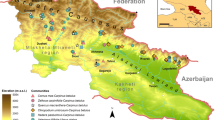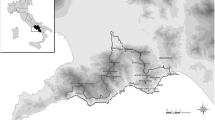Abstract
Wallnöfer S. and Hotter M. 2008. Syntaxonomy and site ecology of mixed oak forest communities in the Inner and Intermedial Alps of Tyrol (Austria). Bot. Helv. 118: 21 – 43.
Mixed oak forest communities dominated by Quercus robur, Q. petraea and Tilia cordata are the natural vegetation of valley bottoms in Tyrol, but only small remnants of these forest remain nowadays. We carried out a comprehensive survey of all remaining stands to document the diversity of forest types, their distribution in the area and their conservation status. Six associations are described based on phytosociological analyses according to the Braun-Blanquet approach combined with correspondence analysis. These are: Genisto germanicae-Quercetum roboris, a species-poor forest type on very acidic soils dominated by Quercus robur; Luzulo niveae-Quercetum petraeae, thermophilous open forests dominated mostly by Q. petraea on moderately acidic base-rich bedrock; Erico-Ostryetum, an association on calcareous soil rich in submediterranean species confined to the south-eastern study area; Sileno nutantis-Quercetum petraeae, a thermophilous oak forest type on calcareous soil developed in the Central Alps; Carici albae-Tilietum cordatae, moderately thermophilous forests on base-rich soil co-dominated by Tilia cordata, Fraxinus excelsior and Quercus robur; Milio effusi-Quercetum roboris, a newly described association dominated by Q. robur and rich in mesophilous tree species, found on moist base-rich soil. This large variety of forest types is attributable to the steep phytogeographical and ecological gradients within the area as well as the local absence of Fagus sylvatica in the most continental parts of the region. However, mixed oak forest communities are nowadays extremely rare and endangered, and oak regeneration was found to be insufficient to maintain the dominance of the species at its present sites. Given the prospective importance of oak due to climatic warming, all oak forest stands should be protected to maintain the species in Tyrol.
Similar content being viewed by others
Author information
Authors and Affiliations
Corresponding author
Additional information
Manuscript accepted 27 March 2008
Rights and permissions
About this article
Cite this article
Wallnöfer, S., Hotter, M. Syntaxonomy and site ecology of mixed oak forest communities in the Inner and Intermedial Alps of Tyrol (Austria). Bot. Helv. 118, 21–43 (2008). https://doi.org/10.1007/s00035-008-0827-1
Published:
Issue Date:
DOI: https://doi.org/10.1007/s00035-008-0827-1




